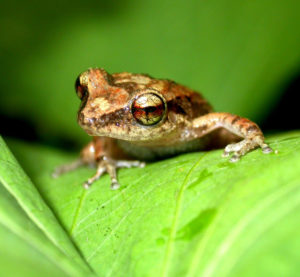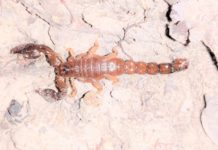
In order to ensure that we implement the best possible conservation interventions, we need to understand as much as possible about the mountain chicken frog and its interactions with disease (specifically chytridiomycosis), invasive species and with its environment. We also need to refine how we keep and breed frogs as part of captive breeding efforts to ensure that we produce frogs fit for release into the wild and for the long term viability of captive populations. For these reasons, research is an integral part of the Mountain Chicken Recover Programme and the results of research projects directly inform not only how we work with the Mountain Chicken, but also helps us deal with threats to amphibians on a global scale.
Mountain chicken research takes place both in the field and in captivity. In the wild, the team conducts regular population surveys, checking for the presence of known animals and documenting new frogs as well as screening the animals for disease so that we understand how many frogs are alive, if they are healthy and if the population is growing or shrinking. We also monitor the progress of animals introduced as part of trial releases from captivity. Regular observation of the frogs in nature has allowed us to begin to document in detail the natural history of mountain chickens, to track the progress of chytridiomycosis epidemics and to understand likely routes of introduction of the disease in the first place. With UK government funding (Darwin Initiative), we will further investigate the ecology of mountain chickens and their interactions with cane toads and tree frogs. These two amphibians are not native to Montserrat and Dominica and, as they are able to be infected with chytridiomycosis with no symptoms, are thought to act as reservoirs and carriers of the fungus.
In captivity, we can study in detail the interactions of mountain chickens with chytrid fungus and try to develop a means for making frogs resistant to the disease. We have also carried out research into the best way to keep mountain chickens in captivity, assessing their nutritional and lighting requirements in order to optimise our housing for frogs. Breeding mountain chickens in captivity has also enabled us to document their bizarre parental care, which had never been seen before the captive population was developed.
Combining research in both captive and wild settings provides a powerful tool for conserving mountain chickens and the involvement of zoo keepers, disease biologists, field scientists and vetinarians in the Programme gives us the range of skill sets needed to do so. Captive frogs have given us the means to develop methods for use in the field, which would be difficult or dangerous to test in wild animals. For example, we have used captive animals to trial means of radio-tagging individual frogs and to develop a body scoring index, which allows people to quantitatively assess whether frogs are a good weight or not. We have also been able to develop and test treatment for chytridiomycosis and the diagnosis of other ailments in captive frogs, which we use in the field to treat sick animals. Equally, data from wild populations can be used to inform captive husbandry to enable us to replicate wild conditions as closely as possible.
Through working together and playing to the strengths of both captive and field research, we can learn more about mountain chickens and how best to defend them against extinction, as well as using them as a model to inform amphibian conservation around the world.






